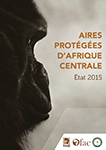The Observatory of Central African Forests (OFAC) has published the first-ever overview of protected areas in the sub-region, which aims to provide the basis for a more comprehensive database for decision makers and contribute to the formation of a network of protected areas in the region.
 23 September 2015: The Observatory of Central African Forests (OFAC) has published the first-ever overview of protected areas in the sub-region, which aims to provide the basis for a more comprehensive database for decision makers and contribute to the formation of a network of protected areas in the region.
23 September 2015: The Observatory of Central African Forests (OFAC) has published the first-ever overview of protected areas in the sub-region, which aims to provide the basis for a more comprehensive database for decision makers and contribute to the formation of a network of protected areas in the region.
The report, titled ‘State of Protected Areas in Central Africa – 2015 Report,’ traces the origins of today’s data gaps to the dual management structures established by colonial administrations more than 100 years ago, where wildlife and biodiversity conservation programmes were viewed as “protectors” of the environment and forestry services were oriented towards the industrial production of timber. The authors emphasize that with the region facing an “unprecedented increase” in poaching, demographic pressures, fragmentation of forests and demand for mineral resources and farmland, it is essential to provide empirical evidence that protected areas are “essential pillars of development” that contribute both to the survival of natural ecosystems and human societies.
The 260-page report contains separate chapters for 10 countries in the sub-region (Burundi, Cameroon, Central African Republic, Chad, the Democratic Republic of the Congo, Gabon, Equatorial Guinea, Republic of the Congo, Rwanda and Sao Tomé and Principe). Each chapter provides basic statistics on the geographical location and size of protected areas, current governance and management structures, and an assessment of their socio-economic contributions and broader legal and institutional aspects.
The report concludes with a chapter focusing on the challenges of protecting transboundary coastal ecosystems along the Atlantic Coast and the Gulf of Guinea. This final chapter highlights the goals of a strategic plan for transboundary marine protected areas (MPAs), launched by RAPAC (Central Africa Protected Areas Network), International Union for Conservation of Nature (IUCN) and other partners in 2012 with the aim of compiling baseline data, identifying sites of ecological importance and developing a strategic plan to build a regional representative network of “functional and coherent” MPAs by 2020.
The study was coordinated by OFAC and RAPAC, under the auspices of the European Union’s BIOPAMA programme, which provides support to African, Caribbean and Pacific (ACP) countries to collect systematic data on protected areas and establish a series of observatories of protected areas. The project was implemented in collaboration with the Central African Forest Commission (COMIFAC), IUCN and the European Commission Joint Research Centre and other partners. [Congo Basin Forest Partnership (CBFP) Announcement] [Publication: State of Protected Areas in Central Africa – 2015 Report (in French)]